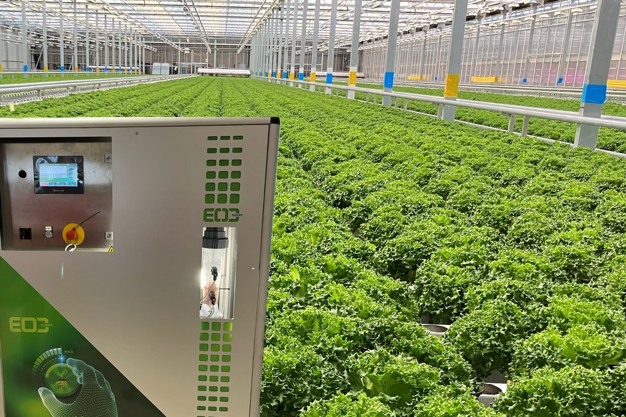The elder people already knew that it is worth letting the irrigation water to rest for a while in contact with air before pouring it on the plants, so that they grow better. Irrigation water is used in large quantities on farms specializing in vegetable and berry cultivation and at the moment, in the beginning of the growing season, they are thinking about how to get the best possible harvest this year. Now it is time to familiarize yourself with the significance of oxygen.
Nano-oxygen water affects plant growth speed, plant hygiene, and health, product quality and shelf life, and thus also productivity.
In project NABLE, Satakunta University of Applied Sciences' (SAMK) research center Wander from Finland has conducted practical research on the use of nano-oxygen water in commercial greenhouses. They have collected user experience on the functionality of nanobubble technology and related parameters that can be measured and monitored. With the help of nano-oxygen technology, oxygen is added into the water in nano-sized oxygen bubbles, which are generated due to the hydrodynamic cavitation phenomenon, where a sudden change of pressure within the liquid generates the nanobubbles.
The oxygen level of the water must be suitable
During the research project, it was noticed that monitoring the concentration of dissolved oxygen in the irrigation water is essential.
One of the key observations is also that simply feeding oxygen-containing nanobubbles into the water alone is not enough and that it is not necessary to add a large amount of them into the water. The oxygen level must be optimized and kept at a certain level to generate the best result.
"Based on the experience gained from the research project, we have developed an automation system for our oxygen nanobubble generator, which can dose the right amount of oxygen, adjust the pressures, and find the right operating parameters for the conditions of each operating environment," says Timo Kantola, CEO of EOD, which developed the Nanoboost® device.
Greenhouses invest in energy efficiency to reduce carbon dioxide emissions and control costs. Nanoboost® nano-oxygen technology and automation system together helps to increase the production efficiency and reduce energy consumption by ensuring that the device produces just the right amount of oxygen for the irrigation water.
Oxygen is the best fertilizer and pesticide
There is a lot of talk about the benefits of having a healthy and versatile diet for people. "We bring the same ideology to the plant side by creating healthy living conditions for plants and through that preventing e.g. plant diseases. Next, we will investigate how nanobubbles affect on the retention of fertilizers in different growing media, such as peat, curd moss, wood fiber, and coconut fiber", continues Kantola.
"Using nano-oxygen water is like doing biological advance control for plants. Nano-oxygen irrigation water maintains the natural well-being of plants, which reduces the need to use plant protection agents. In this way, the chemical load on waterways and soil can also be reduced," says Toni Tanner from Hortiherttua, who grows herbs, lettuce, cucumbers, and tomatoes in Karjalohja, Finland.

Less crop loss
In particular, the profitability challenges of organic production are related to the uniform quality of the harvest and reducing the amount of crop loss.
"We have evidence that, for example, salads grow more evenly with the help of nano-oxygen water," says Martti Latva, SAMK Wander's research manager.
For example, when air is fed into the irrigation water with a compressor, about 80% of the gas is nitrogen, which the plant cannot utilize. With this method, the oxygen is not stored in the water as larger bubbles escape from the water and only a minor part of oxygen has time to dissolve. Nanoboost®'s molecular sieve collects oxygen, returns nitrogen back to the air, and directs only oxygen into the water. Oxygen is made into nanobubbles, from where it is slowly released into the water so that energy is not wasted.
During the research, it has been noticed that the plants withstand stressful situations better when nano-oxygen water has been used for irrigation instead of regular water, which has reduced crop loss. Stressful situations are caused, for example, by blockages in the drip nozzles, in which case the plant may have to suffer from unexpected drought. Too much heat, cold, or darkness during system failure can also cause stress to the plants. Plants irrigated with nano-oxygen water grow stronger roots, which improves their stress resilience and immunity.
According to Tanner, the farmer gets more peace of mind when the plants cope better in possible stressful situations.
The technology must be easy to use
Solutions that improve cultivation can be a headache if they are difficult to install or complicated to use. "New technology must be easy and simple to install, use, and maintain so that the farmer can focus on running the farm. You shouldn't need to be an engineer to use a piece of new equipment," emphasizes Schetelig Oy's product group manager Tony Joas. The Nanoboost® oxygen nanobubble generator represented by Schetelig already has a dozen farmer users in Finland. The easy-to-use and reliable technology ensures that farmers can take advantage of the benefits it offers effortlessly and focus on what is essential: growing a high-quality crop.
For more information:
EOD Oy
Joensuunkatu 7, FI-24100
+358 449016222
info@eod.fi
eod.fi
